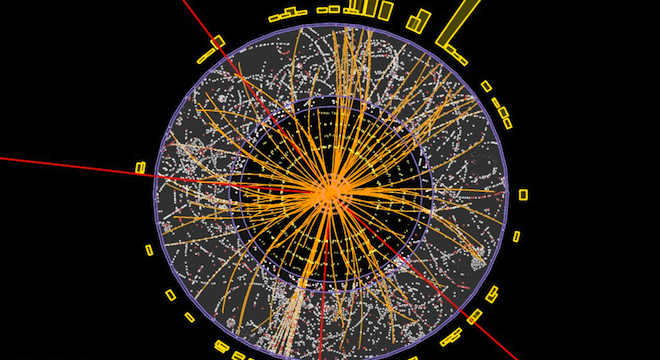The discovery of a long sought-after particle known as the Higgs boson — which has been nicknamed “the God Particle” because physicists theorize it is the missing piece to understanding how all matter in the universe has mass — could be announced Wednesday, July 4.
The European Organization for Nuclear Research (CERN), the international scientific agency in charge of the world’s largest and most powerful particle accelerator, the Large Hadron Collider, on Friday sent out a press release confirming it would reveal the results of its latest high-energy proton beam collision experiments at a conference in Melbourne, Australia, taking place between July 4 and July 11.
The results, which have been eagerly awaited by the physics community around the globe and other science buffs, are expected to help shed light on CERN’s late 2011 findings, which helped narrow down the range of energies in which Higgs was likely to be detected, below 124 GeV.
“We now have more than double the data we had last year,” said CERN Director for Research and Computing, Sergio Bertolucci, in a statement. “That should be enough to see whether the trends we were seeing in the 2011 data are still there, or whether they’ve gone away. It’s a very exciting time.”
To be clear, there are no solid indications yet of precisely what CERN has seen in this round of data collection. Nonetheless, a few physics bloggers and the mainstream media have for the past few weeks been excitedly passing around rumors that the agency has indeed discovered Higgs among the remnants of its proton beam collisions.
As CERN’s release explained:
If and when a new particle is discovered, ATLAS and CMS will need time to ascertain whether it is the long sought Higgs boson, the last missing ingredient of the Standard Model of particle physics, or whether it is a more exotic form of the boson that could open the door to new physics.
“It’s a bit like spotting a familiar face from afar,” said CERN Director General Rolf Heuer, “sometimes you need closer inspection to find out whether it’s really your best friend, or actually your best friend’s twin.”
But CERN could have also seen something much less conclusive. In fact, it is likely that the recent observations have only helped further narrow the energy range in which the missing “god particle” might exist.
Or, in the most shocking case of all, the data could indicate that the 2011 results were merely the result of random chance and not statistically significant enough to narrow the range whatsoever.
If the Higgs particle isn’t precisely located in this round of data, it will mean that scientists will have to look for a different type of particle than they thought in order to confirm their most-widely agreed upon theory of how matter has mass, known as the Standard Model.
If no such alternative Higgs particle can be found, scientists may have to look to other, less generally accepted theories behind the mass in the universe, such as theories of Technicolor Physics, which broadly suggest that quarks — fundamental building blocks of atoms — come in more types than previously thought.
In any case, CERN’s upcoming announcement has spurred debate about whether the organization’s controlled approach to releasing the data is too secretive, and whether or not apparent “leaks” are legitimized as a result.
One scientist working on the Large Hadron Collider, hit back at the idea, promoted by The New York Times, that the results were being guarded. As researcher Seth Zenz wrote on the blog Quantum Diaries: “There’s nothing to keep secret about our Higgs boson search, because we’re simply not done.”
CERN’s new round of data — which has been collected by two separate enormous detector instruments called ATLAS and CMS, both situated along the 17-mile-around underground ring that is the Large Hadron Collider, itself located near Geneva, Switzerland — was this time the result of even higher energy collisions than ever before, 8 teraelectron volts, each near light speed beam enough to kill a person if they were to hypothetically put their hand in the way of the beam (CERN says this is almost impossible due to the safety measures in place).
The Large Hadron Collider, nicknamed the “Big Bang Machine” because it is designed to simulate the conditions of the early universe, slams the two beams together over and over again, producing short-lived particle debris. It’s in these debris that scientists are looking to catch a glimpse of the Higgs.






